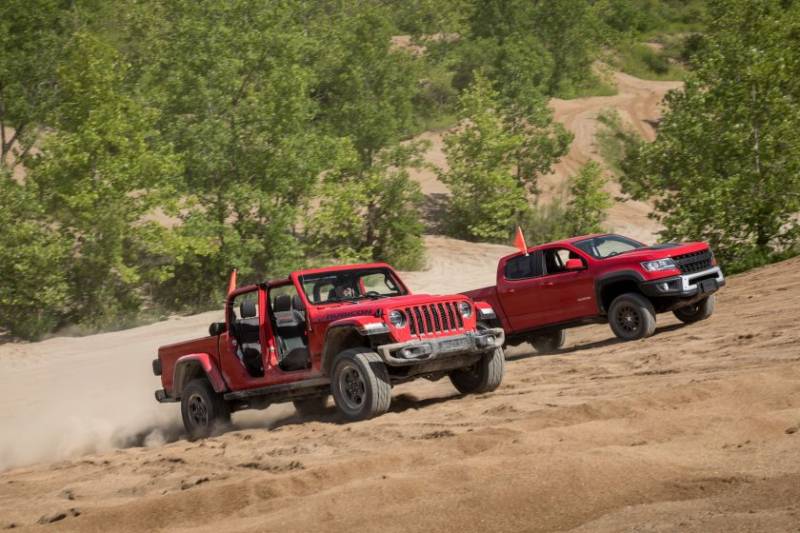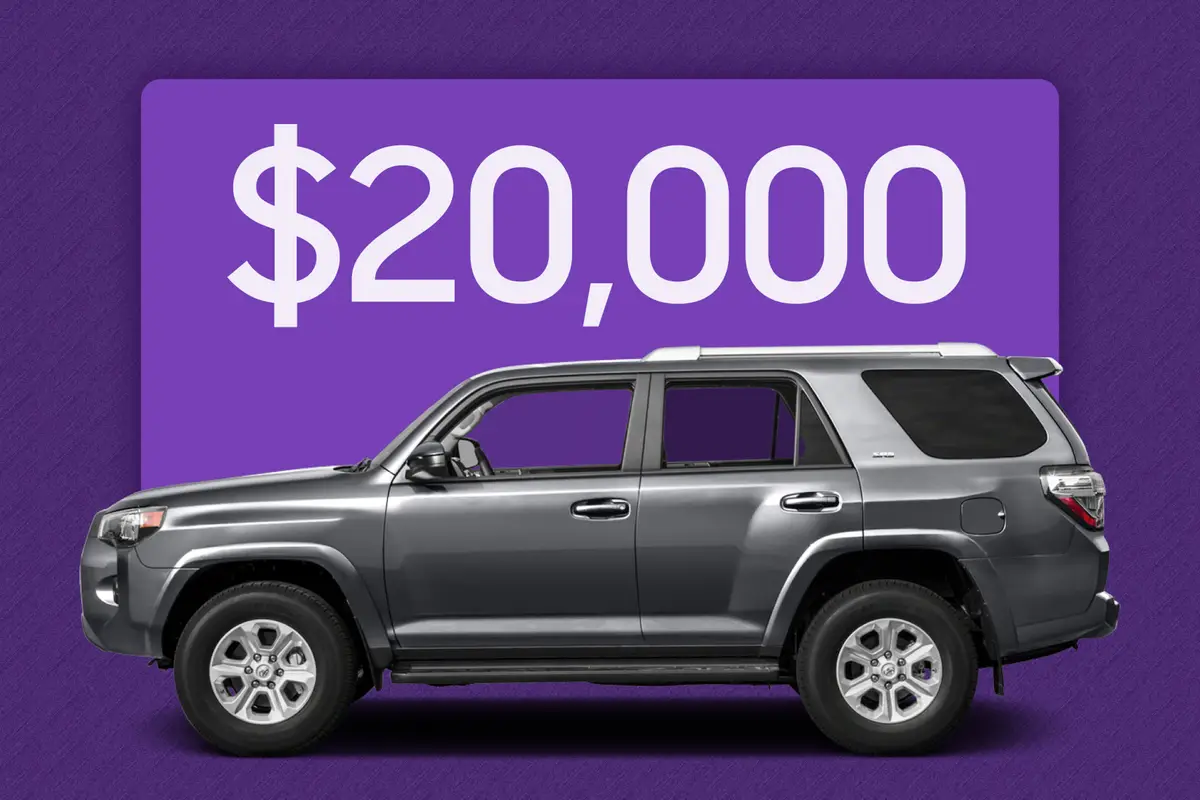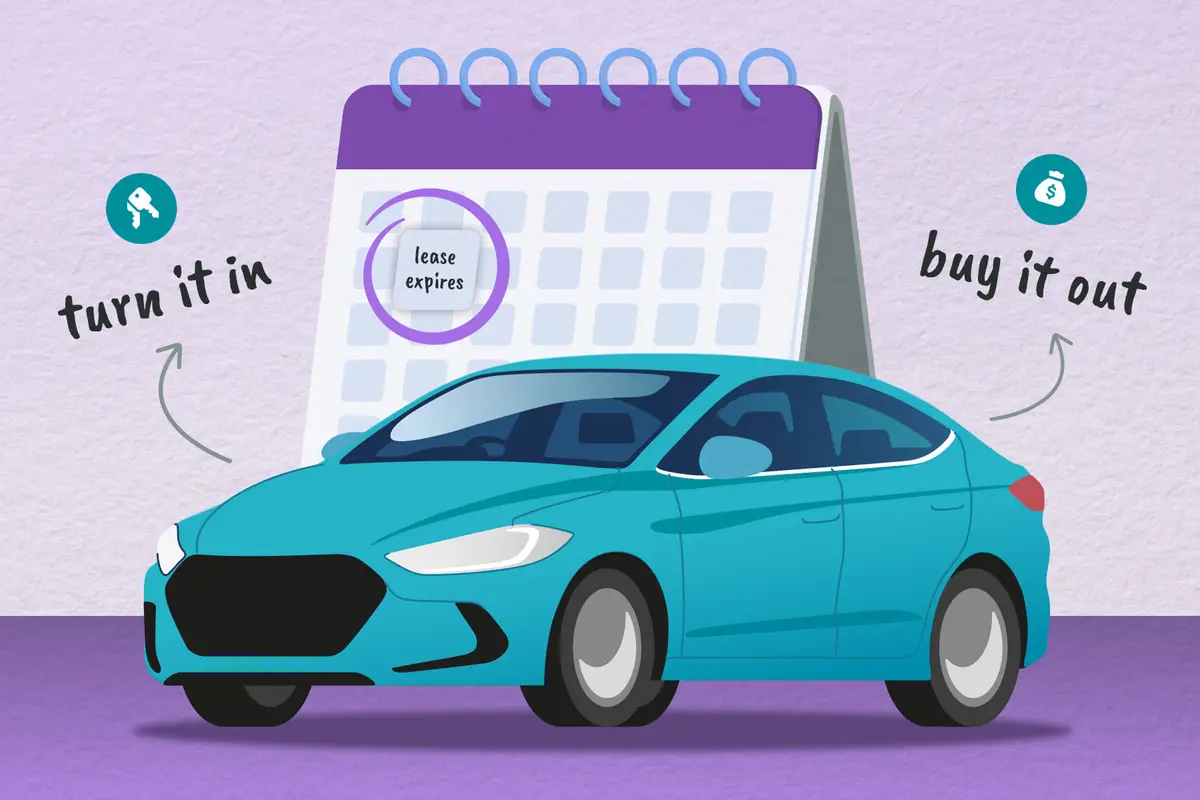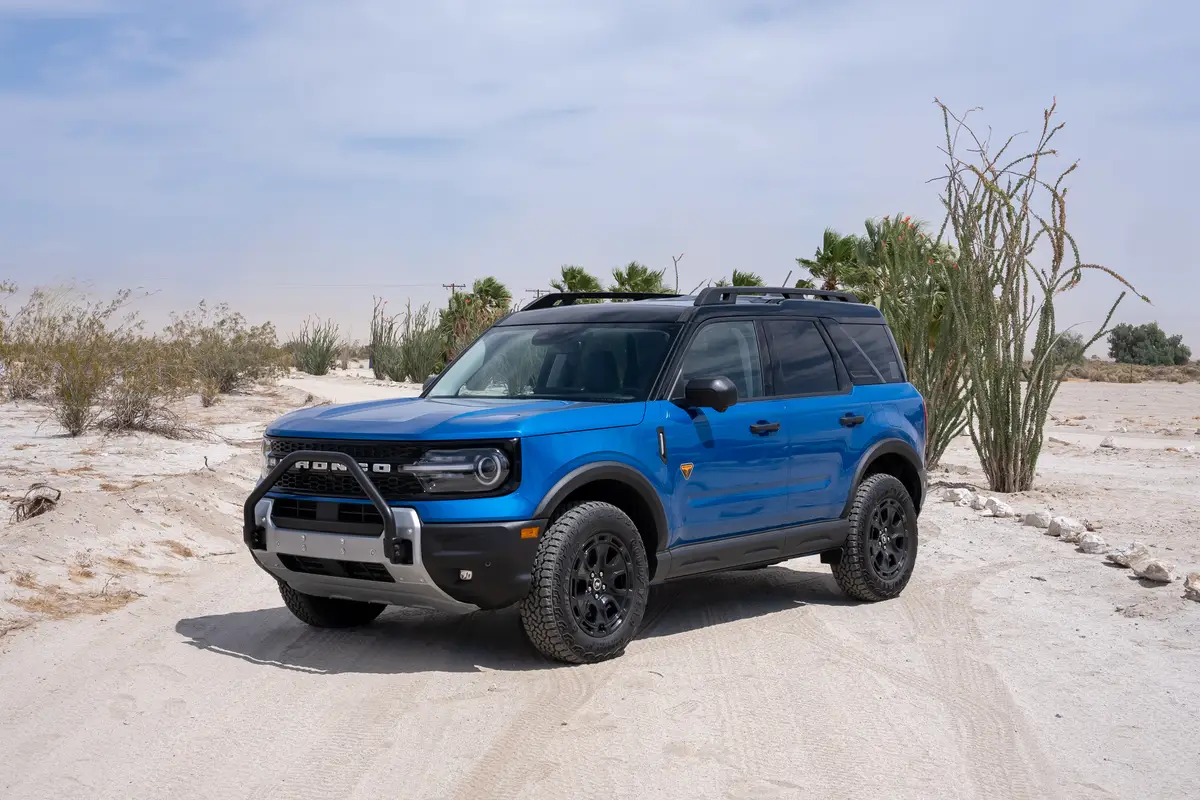Off-Road Comparison: Can the Gladiator Rubicon Dethrone the Colorado ZR2?

Two years ago, we brought you a competition between two of the toughest off-road mid-size pickup trucks in the land: the Toyota Tacoma TRD-Pro, an aging but highly capable rig that made use of extraordinary electronics to boost its off-road abilities, and the then-new Chevrolet Colorado ZR2. The special ZR2 off-road version of the Colorado mid-size pickup featured front and rear electronic locking differentials, spiffy Multimatic shock absorbers, a lifted body and big knobby tires meant for climbin’ and crawlin’ through the dirt and rocks. The Colorado just barely eked out a win in that fight by the benefit of its fabulous trick shocks, which were able to swallow bumps and perform magically across a variety of terrain.
Fast-forward two years, and we have a new challenger for the Colorado ZR2: the new-for-2020 Jeep Gladiator Rubicon. It’s the first pickup truck from the off-road Jeep brand in decades, and it’s quite something. The Gladiator is long, strong and ready to get its Jeepin’ on. Cars.com Executive Editor Joe Wiesenfelder and I had to find out if it could unseat the latest version of the Colorado ZR2 in a straight-up fight through the wilderness trails, sand pits and rock tables of Indiana’s Badlands Off Road Park. An on-road evaluation of these trucks is coming where we’ll evaluate how trucky they are in their street clothes, but for this test, it’s all about the most capable off-road versions.
The Venue: The Best Little Off-Road Park You’ve Never Heard Of
Hold up, Indiana? Aren’t the Badlands in South Dakota? Yes, but you’re thinking of the Badlands National Park — this is a different Badlands altogether, more than 800 acres of former quarry and wilderness about 30 minutes from West Lafayette, Ind. The terrain is incredibly varied: deep sand, steep rock climbs, challenging woodland trails, mud, water — you name it, it has everything but cactus. This is where the Jeep Jamboree holds one of its regional adventures, so you know it has to be good. And it is.
Contestant No. 1, the Defending Champ: 2019 Chevrolet Colorado ZR2 Bison
Our reigning champion gets a slight upgrade for 2019. This is the new , a special edition of the ZR2 that’s received new parts courtesy of Chevrolet’s partnership with off-road parts supplier American Expedition Vehicles. The Bison swaps out parts from the already massively capable ZR2. Most notable is the addition of five skid plates covering the oil pan, fuel tank, transfer case, and front and rear differentials, all made from hot-stamped boron steel. New stamped-steel bumpers are fitted front and rear, the front one providing less ability to climb taller obstacles given its full width and tire protection versus the ZR2’s standard bumper. It actually decreases the ZR2’s 30-degree approach angle to 25.3 degrees. For all of the Colorado and Gladiator’s specifications, check out our spec comparison at the bottom of this article.
As with all ZR2s, you already get the extraordinary Multimatic Dynamic Suspensions Spool Valve off-road shock absorbers that allow you to traverse moonscape-like terrain with ease. Also included are 31-inch Goodyear Wrangler DuraTrac tires on 17-inch AEV Bison-specific wheels and an Off-Road mode to make it all work in unison. The standard engine is a 308-horsepower, 3.6-liter V-6 making 275 pounds-feet of torque, but our test truck came with the optional 186-hp, turbo-diesel 2.8-liter four-cylinder upgrade putting out 369 pounds-feet of torque and mated to a standard six-speed automatic transmission. We were curious to see how the torque-monster diesel would fare off-road given that it’s the only diesel mid-size truck you can buy in the U.S. (for the moment). Also, it was the only engine Chevrolet had available to test, it seems. Total cost for one of these babies off the showroom floor is a hefty $53,245, including destination.
Contestant No. 2, the Challenger: 2020 Jeep Gladiator Rubicon
Featuring a chassis stretched from the already long Jeep “JL” Wrangler four-door, the 2020 Jeep Gladiator “JT” has a longer wheelbase in order to accommodate the same size cabin as the Wrangler, but it adds a 5-foot pickup bed out back. Like the Wrangler, it’s powered by a 285-hp, 3.6-liter Pentastar V-6 making 260 pounds-feet of torque and mated to an eight-speed automatic or six-speed manual. The tested Rubicon features the off-road boosts that help the Wrangler conquer all obstacles: a 1-inch lift, 33-inch Falken Wildpeak tires, taller fenders to allow for bigger tires should you care to fit some, Fox shocks, electronic locking front and rear differentials, an electronic disconnect for the front sway bar and a super-low 77.24:1 crawl ratio creeper gear. It also offers two things that the Wrangler doesn’t yet: a forward-facing trail camera and an Off-Road Plus mode button, which facilitates high-speed off-road driving when in 4-High mode and tweaks the traction control and drivetrain more for rock crawling when in 4-Low.
Related:
Of course, the top and doors are removable, making this the only standard convertible pickup in the world. Total price for this loaded Rubi: a jaw-dropping $60,965. Yep, nearly 61 kilodollars. Yikes.
Test 1: High-Speed Sand and Gravel
The first test we threw at these trucks was a high-speed, loose-sand-and-gravel run with changing elevation and tight turns to see how responsive they were at higher speeds. After lowering the air pressure in both trucks’ tires to a more off-road friendly 20 pounds per square inch, we encountered our first unexpected challenge with these beasts: What buttons do we push?
It used to be that if you wanted to go off-road, you just had to know how to set up your truck and how to drive it properly — what gear to be in, whether to engage low range (if your rig had one), how to apply throttle, whether to lock axles or disconnect sway bars, etc. But then electronics came along that adjust a lot of these things at the push of a button, so now the challenge is knowing what buttons to push, what settings to run and what buttons perform what adjustments.
It’s more complicated than it sounds.
“We used to have to learn what to engage to go off-roading,” Wiesenfelder said. “Now we have to learn what to disengage. If you have to provide a matrix that shows what happens depending on which of the various settings you’ve chosen, you probably ought to start making additional modes.”
Yes, the Colorado has a full matrix of conditions to help you decide what buttons to push. No joke, it’s part of the owner’s manual, so you’ll have to take time to study the thing if you want to make sure you’ve pushed the right buttons for your conditions. It’s the same thing in the Gladiator: There’s one button, the Off-Road Plus mode, and it adjusts throttle response and stability control. So now you have to figure out whether to push that button for your task or whether to set things up in other ways, like manually disabling stability control or just traction control, whether to lock the rear axle only or the front as well, etc. Some automakers make this a little easier with a dial, like the Toyota Tacoma’s Multi-Terrain Select that describes the conditions (Sand, Mud & Ruts, Rock, Snow) that adjusts things for you. But neither the Colorado nor the Gladiator offer that level of specificity.
So it took us more than a few passes to dial in both vehicles to the proper settings. But once we had, the difference between these two trucks in the high-speed sand became clear: The Colorado likes to catch air, the Gladiator does not. To be more specific, the Gladiator likes to — it just hates the landing, which it will do with a teeth-cracking slam instead of a softer, more controlled splash like the Colorado does.
“After a few minutes of storming through the dunes at up to 40 mph with the Colorado’s Multimatic shock absorbers soaking up the impacts brilliantly, I switched to the Gladiator and promptly bottomed out twice. Ouch,” Wiesenfelder said.
On the other hand, throttle modulation in the gasoline-powered Jeep was far better on high-speed runs than the diesel-powered Colorado. When put in Off-Road Plus mode, the throttle mapping changes in the Jeep, making engine response far more immediate, which was an absolute hoot in the tail-out drifting we did in the sand. You can control the drifting of the Gladiator with your right foot, but the Colorado is a half-tick behind in its engine response, and being a diesel, it runs out of steam just past its rpm mid-range. So for purposes of the sand test, it was something of a tie: The Colorado had the better high-speed suspension, able to soak up bumps with ease, but the Gladiator had the better powertrain response.
Test 2: Hill Climb, Two Ways, Two Hills
So then to the hill climb, two ways — one steep with well-packed dirt and rock, the other still steep but with loose sand and pea gravel. Here again, the powertrain made all the difference, and once again, knowing what buttons to push to set up the truck properly was important. The steep, hard-packed hill was no challenge for either truck. We just pointed them at it, power on, and up they both went, axles locked or not, but honestly probably not even necessary. The sandy hills were much more of a challenge, again due to the powertrain differences. Whereas the Gladiator made short work of the sandy hill thanks to its ability to keep the power on and the torque flowing, the Colorado had issues with the same track up the grade due to its engine sputtering when the electronic nannies took over, cutting power prematurely again and again. When we finally figured out the things to shut off on the Colorado, its copious torque eventually bested the Gladiator in a straight-up, bottom-of-the-hill-to-the-top drag race, but only by a hair.
Test 3: Rock Crawling
Rock crawling unveiled many differences between these trucks, most notably in their construction. The Jeep’s approach angle of 43.4 degrees is far better than the nose-heavy Colorado’s 25.3 degrees. Credit the Gladiator’s design that has much less front overhang (29.7 inches) thanks to its bulldog-like flat face, whereas the Colorado has far more schnoz to deal with (37.3 inches). The AEV bumper didn’t actually help much here, as it covers the front tires in ways that the standard ZR2 bumper does not. You’d think that the Gladiator’s additional length would work against it, too (its wheelbase is nearly 9 inches longer than the Colorado crew cab’s), not to mention the rear overhang requires special rock rails due to the bed’s length behind the rear axle (51.0 inches versus the Colorado’s 47.2 inches). But the Gladiator made it over obstacles that the Colorado couldn’t even approach due to that front length. Yeah, it banged and gronked breaking over those obstacles, but that’s what the skid plates are for, right?
The point is, the Gladiator made it up some seriously sheer rock obstacles at a 26-degree overall angle, while the Colorado had to take an easier line up the hill. To be fair, somewhere in this park was probably a sharp peak on which the Rubicon might have gotten high-centered and the Chevy might not, but we didn’t experience it. The Bison’s breakover angle of 23.5 degrees is only slightly better than the Rubicon’s 20.3 degrees, and it has a considerable ground-clearance disadvantage of 8.9 inches versus the Rubicon’s 11.1 inches. Ultimately, the Gladiator’s long wheelbase wasn’t as much of a disadvantage as we’d feared, and its approach angle was a big plus.
Another big plus, according to Wiesenfelder, were those removable doors: “There’s no question having the doors off is more fun, but it made a profound difference in our ability to see the trail ahead and place a tire where it needed to go. The side mirrors go with the doors, so you can hold onto the roof rail and lean way out without unbuckling your seat belt, seeing so much that’s blocked by the ZR2’s tall hood and doors.”
One would think the Colorado’s low-end diesel grunt would give it an advantage on the rocks, but the way it responded to inputs as well as its inferior crawl ratio held it back. “The Gladiator moseyed up hills with minimal grunting, slipping or bouncing,” said Wiesenfelder. “The Colorado had more of all of that, though it was never left behind. Perhaps the most frustrating aspect of the Chevy was its throttle response.”
The Gladiator has a creeper gear with a crazy-low 77.24:1 crawl ratio, while the Colorado has to make do with 37.8:1. Though its engine has less torque to begin with, the Gladiator’s gearing translates to plenty at the wheels. If steep, slow-speed rock crawling is your kind of off-road fun, the Gladiator is your easy choice — maybe too easy.
Test 4: Street Driving
Getting to the trails is just as important as how you do on them, so we also evaluated what these two trucks were like to drive on the road. It’s here that the Colorado’s more civilized underpinnings began to show through. Even with the diesel engine, the Colorado was quieter, thanks to not having a roof made of plastic or drain holes in the floor plugged by grommets in the rubber floormats, as the Gladiator did. But the front suspension also played a major part in civilizing the Colorado; it’s an independent front suspension for the Chevy, whereas the Jeep still makes do with a solid heavy-duty Dana 44 live axle. That solid axle also necessitates recirculating ball steering, a technology that was replaced by rack and pinion, and later electrically assisted systems in most passenger cars decades ago.
Related: More Mid-Size Pickup Truck News
What it translates to is surface street and highway handling in the Gladiator that’s better than Jeeps of the past but still not comparable to most crossovers, SUVs and pickups of modern times. Get a good crosswind going and the Gladiator is all over its lane, sometimes alarmingly so. The Colorado experiences no such wandering. As for ride quality, they’re very similar in that they both have fairly supple rides thanks to soft shocks, big balloon tires and, in the Gladiator’s case, a significantly long wheelbase.
The Gladiator is also bigger inside and out. The Colorado feels plainer, more utilitarian, certainly far less of a premium product than the Gladiator. This is especially true inside, where the Colorado’s boring, plasticky cabin doesn’t hold a candle to the industrial chic of the Jeep.
The Verdict: Each Good at Something, Hard to Declare a Winner
Declaring an off-road winner between these two is more difficult than when we threw the ZR2 up against the Toyota Tacoma TRD Pro. Those two trucks had very similar specs and missions — but the Gladiator is simply an entirely different kind of animal than the ZR2. It’s more robust in some ways, better equipped to tackle certain off-road tasks like rock crawling but less adept at high-speed off-road terrain.
The ZR2’s diesel engine and six-speed automatic just isn’t the right powertrain for this truck — we’re very curious to see how a gasoline engine version differs. But the ZR2’s fantastic shocks once again save its bacon — not enough to declare it the winner, but enough to keep it from being the loser, as we’re going to have to declare this one as “different strokes for different folks.” Buyers are likely to be happy with either choice, but your choice should depend on how you intend to use your truck.
If you’re planning on blasting across the countryside at higher speeds, the Chevrolet Colorado is the better choice. Just be sure to try out both the gasoline and diesel powertrains to see which one is best for your style of off-roading. If you’re an overlander or rock crawler, the bigger, more capable Jeep Gladiator with its more sophisticated four-wheel-drive system, super-low crawl ratio and additional gears is the way to go.
More From PickupTrucks.com:
| Test vehicles as equipped; data does not represent other trim levels or drivetrains. |
2019 Chevrolet Colorado |
2020 Jeep Gladiator |
| Price as Equipped | $53,245 | $60,965 |
| Final Assembly | Wentzville, Mo. | Toledo, Ohio |
| Versus Lesser Trim Levels |
|
|
| Underbody Protection |
|
|
| Overall Length (Inches) | 212.4 | 218.0 |
| Width (Inches) | 76.7 | 73.8 |
| Wheelbase (Inches) | 128.5 | 137.3 |
| Track
(Front and Rear, Inches) |
65.9 | 64.4 |
| Ground Clearance (Inches) | 8.9 | 11.1 |
| Approach Angle (Degrees) | 25.3 | 43.4 |
| Breakover Angle (Degrees) | 23.5 | 20.3 |
| Departure Angle (Degrees) | 23.5 | 26.0 |
| Engine | Optional turbo-diesel 2.8-liter Duramax four-cylinder | Standard gas 3.6-liter Pentastar V-6 |
| Horsepower | 186 @ 3,400 rpm | 285 @ 6,400 rpm |
| Torque (Pounds-Feet) | 369 @ 2,000 rpm | 260 @ 4,400 rpm |
| Transmission | Standard six-speed automatic | Optional eight-speed automatic |
| EPA-Estimated MPG (City/Highway/Combined) | 18/22/19 | 17/22/19 |
| Center Differential Ratio | 2.72:1 | 4.00:1 |
| Rear Axle Ratio | 3.42:1 | 4.10:1 |
| Crawl Ratio | 37.8:1 | 77.24:1 |
| Center Differential Settings |
RWD, Auto, 4-High, Neutral, 4-Low |
RWD, 4-High, Neutral, 4-Low |
| Driver-Selectable Locking Differentials |
Front and rear axles (In 4WD High, only rear is lockable, at low speeds) |
Front and rear axles
(Operable in 4WD Low only) |
| Front Suspension |
|
|
| Rear Suspension |
|
|
| Steering | Rack and pinion | Recirculating ball |
| Wheels | American Expedition Vehicles- designed, ZR2 Bison-specific 17- inch aluminum wheels | Rubicon-standard 17-inch Granite Crystal aluminum wheels |
| Tires | 31-inch diameter Goodyear Wrangler DuraTrac 265/65R17 |
33-inch diameter Falken Wildpeak A/T 285/70R17 |
| Curb Weight (Pounds) | 5,012 | 5,072 |
| Payload (Pounds) | 1,162 | 1,160 |
| Maximum Trailer Weight (Pounds)** | 5,000 | 7,000 |
Manufacturer data; *may require optional equipment
PickupTrucks.com’s Editorial department is your source for automotive news and reviews. In line with PickupTrucks.com’s long-standing ethics policy, editors and reviewers don’t accept gifts or free trips from automakers. The Editorial department is independent of PickupTrucks.com’s advertising, sales and sponsored content departments.


Detroit Bureau Chief Aaron Bragman has had over 25 years of experience in the auto industry as a journalist, analyst, purchasing agent and program manager. Bragman grew up around his father’s classic Triumph sports cars (which were all sold and gone when he turned 16, much to his frustration) and comes from a Detroit family where cars put food on tables as much as smiles on faces. Today, he’s a member of the Automotive Press Association and the Midwest Automotive Media Association. His pronouns are he/him, but his adjectives are fat/sassy.
Featured stories




